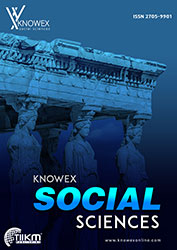INTERACTING WITH READERS THROUGH THE USE OF METADISCOURSE IN COVID-19 NEWS
DOI:
https://doi.org/10.17501.27059901.2023.3106Keywords:
COVID-19 news, metadiscourse, students, writing promptsAbstract
Metadiscourse is the way in which writers engage the readers to the discourse and reveal the writers’ authority towards the content of the discourse making it credible (Crismore, 1989; Hyland, 1998, 2000). These features are investigated in this study due to the lack of appropriate guidelines in reference books, manuals or websites on journalism to write news specifically (Khattak, Yaqoob, & Basri, 2003). This study aims to find out how important metadiscourse features is in COVID-19 news. Two sets of news printed versions with and without metadiscourse, as well as writing prompts were given to 11 students from journalism courses and 11 students from non-journalism course from a local university to read in order to obtain their perceptions of the use and importance of metadiscourse features in COVID-19 news. This study will compare the students’ responses to the COVID-19 news to gauge their feedback on which news is more engaging.
Downloads
References
al Jazeera. (2021, March 12). Malaysia cites Covid-19 misinformation with new ‘fake news’ law. Al Jazeera.
Amiryousefi, M., & Eslami Rasekh, A. (2010). Metadiscourse: Definitions, issues and its implications for English teachers. English Language Teaching, 3(4), 159–167.
https://doi.org/10.5539/elt.v3n4p159
Bal Gezegin, B., & Bas, M. (2020). Metadiscourse in academic writing: A comparison of research articles and book reviews. Eurasian Journal of Applied Linguistics, 6(1), 45–62.
https://doi.org/10.32601/ejal.710204
Bernama. (2022, May 27). Journalists’ associations should play greater role in training media practitioners-Annuar. Bernama. https://www.bernama.com/en/general/news.php?id=2085218
Bo, C. (2015). Social constructivism of language and meaning. Croatian Journal of Philosophy, 15(1), 87–113.
Boshrabadi, A. M., Biria, R., & Zavari, Z. (2014). A cross cultural analysis of textual and interpersonal metadiscourse markers: The case of economic articles in English and Persian newspapers. Advances in Language and Literary Studies, 5(2), 59–66.
Centers for Disease Control and Prevention. (2021). Basics of covid-19. Centers for Disease Control and Prevention. https://www.cdc.gov/coronavirus/2019-ncov/your-health/about-covid-19/basics-covid-19.html
Dafouz-Milne, E. (2008). The pragmatic role of textual and interpersonal metadiscourse markers in the construction and attainment of persuasion: A cross-linguistic study of newspaper discourse. Journal of Pragmatics, 40(1), 95–113. https://doi.org/10.1016/j.pragma.2007.10.003
Hafizah Anwardeen, N., Ong Luyee, E., Indra Gabriel, J., & Ali Rezvani Kalajahi, S. (2013). An analysis: The usage of metadiscourse in argumentative writing by Malaysian tertiary level of students. English Language Teaching, 6(9), 83–96. https://doi.org/10.5539/elt.v6n9p83
Hyland, K. (2004). Patterns of engagement : Dialogic features and L2 undergraduate writing. In Louise J. Ravelli & Robert A. Ellis (eds) (Eds.), Analysing academic writing : Contextualized frameworks (pp. 5–23). Bloomsbury Academic. https://doi.org/10.5040/9781474211741.ch-002
Hyland, K. (2018). Metadiscourse: Exploring interaction in writing. Bloomsbury Publishing.
Jack, C. (2017). Lexicon of lies: Terms for problematic information. Data & Society.
Joharry, S. A., & Turiman, S. (2020). Corpus stylistic analysis of Malaysian online columnists. Journal of Modern Languages, 30(2), 53–80. https://doi.org/10.22452/jml.vol30no2.3
Latif, Y. A. (2022, February 27). Influencers spreading fake news about boosters, says expert. Free Malaysia Today.
Lo, Y. Y., Othman, J., & Lim, J. W. (2020). The use of metadiscourse in academic writing by Malaysian first-year ESL doctoral students. Indonesian Journal of Applied Linguistics, 10(1), 271–282. https://doi.org/10.17509/ijal.v10i1.25069
Mohamed, A. F., Ab Rashid, R., & Lateh, N. H. M. (2021). The use of metadiscourse markers in Malaysian undergraduate persuasive essay corpus at Universiti Malaysia Kelantan. Kresna Social Science and Humanities Research, 1, 1–3. https://doi.org/10.30874/ksshr.38
Nash, W. (2021). An uncommon tongue the uses and resources of English (1st ed.). Routledge.
Ngadiron, S., Abd Aziz, A., & Mohamed, S. S. (2021). The spread of COVID-19 fake news on social media and its impact among Malaysians. International Journal of Law, Government and Communication, 6(22), 253–260. https://doi.org/10.35631/IJLGC.6220024
Nugroho, A. (2020). Investigating the use of metadiscourse markers by American and Indonesian writers in opinion and business articles. Journal of English Language and Culture, 10(2), 75–87. https://doi.org/10.30813/jelc.v10i2.2138
Parker, C., Scott, S., & Geddes, A. (2019). Snowball sampling. SAGE research Methods Foundations. SAGE Publications Ltd. https://doi.org/10.4135/9781526421036831710
Potter, W. J. (2018). Media literacy. Sage Publications.
Qistina, S. (2022, August 26). Avoid complacency during endemic phase, Malaysians reminded. New Straits Times. https://api.nst.com.my/news/nation/2022/08/825846/avoid-complacency-during-endemic-phase-malaysians-reminded
Rafeeq, A., & Jiang, S. (2018). From the Big Three to elite news sources: A shift in international news flow in three online newspapers TheNational.ae, Nst.com.my, and Nzherald.co.nz. The Journal of International Communication, 24(1), 96–114. https://doi.org/10.1080/13216597.2018.1444663
Shafique, H., Shahbaz, M., & Hafeez, M. R. (2019). Metadiscourse in research writing: A study of native English and Pakistani research articles. International Journal of English Linguistics, 9(4), 376–384. https://doi.org/10.5539/ijel.v9n4p376
Tagliabue, F., Galassi, L., & Mariani, P. (2020). The “pandemic” of disinformation in COVID-19. SN Comprehensive Clinical Medicine, 2(9), 1287–1289. https://doi.org/10.1007/s42399-020-00439-1
van der Linden, S., Roozenbeek, J., & Compton, J. (2020). Inoculating against fake news About COVID-19. Frontiers in Psychology, 11, 1–7. https://doi.org/10.3389/fpsyg.2020.566790
Wang, L., & Zhang, Y. (2017). An analysis of theoretical and empirical studies on metadiscourse. International Journal of Research-Granthaalayah, 5(4), 118–127. https://doi.org/10.29121/granthaalayah.v5.i4.2017.1801
Downloads
Published
Issue
Section
License
Copyright (c) 2023 Darryl Chow, Dr. Hooi Chee Mei, Dr. Sharon Wilson, Tan Yee Woon, Henry Tan

This work is licensed under a Creative Commons Attribution 4.0 International License.







